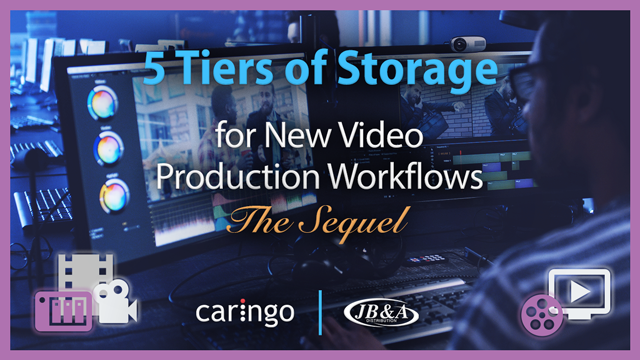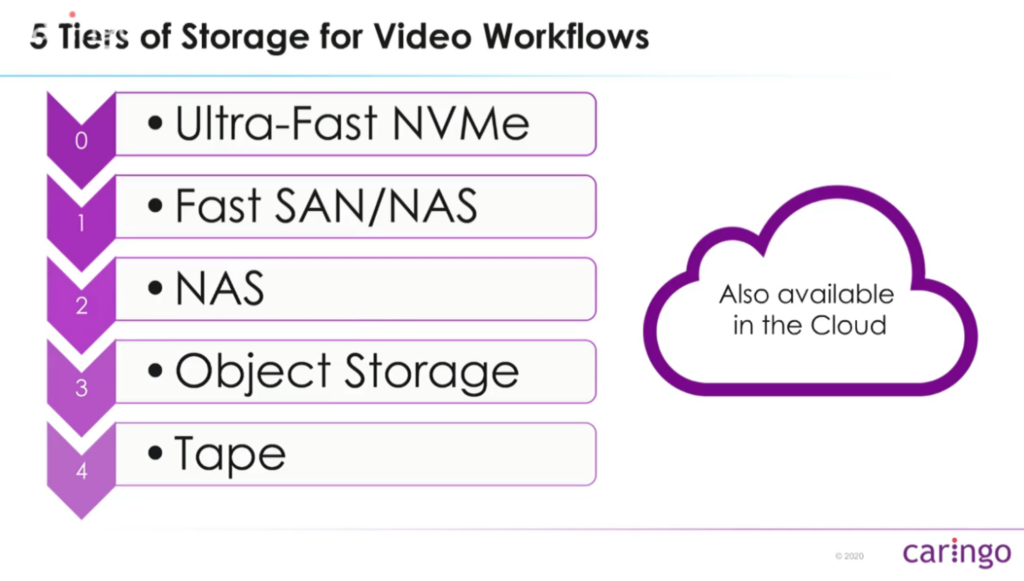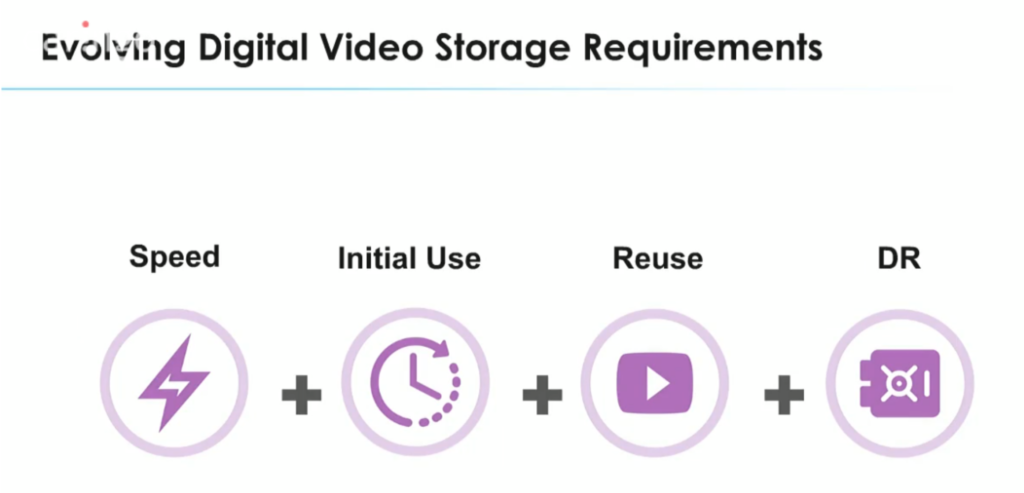M+E Daily

Caringo Exec: Storage Plays a Starring Role in Today’s Remote World
Story Highlights
The march towards enabling remote workflows has only picked up steam in today’s video production world as a result of the pandemic and some processes will never be the same, but storage continues to play a critical role, according to Adrian Herrera, Caringo VP of marketing
Ever since he and Nick Smith, VP of technology at JB&A Distribution, held the webinar “5 Tiers of Storage for New Video Production Workflows” in 2018, Herrera kept getting asked the same question, he said Aug. 4 during a follow-up webinar to it.
Was that question “why is my head so bald?” Smith jokingly responded during the new webinar “5 Tiers of Storage for New Video Production Workflows: The Sequel.”
No, the question that Herrera kept being asked was when would they be doing the sequel, he said.
During that sequel, the Caringo executive pointed out that obviously “a lot has changed in those 18 months” in between the webinars – especially as a result of the COVID-19 pandemic.
Indeed, Smith conceded, noting that “nobody cares about anything that was more than” five or six months ago due to the pandemic, which has resulted in just everybody able to work from home being forced to work remotely.
 Smith told viewers: “It’s been a mad dash for all of our clients and their clients of ‘how do I do what I did before, but do it from home on home network infrastructures, on home Internet connections – remotely with my clients, with my partners and my coworkers? And how do I do what I did but do it from a house with my kids screaming in the background, with my cat running across my keyboard?”
Smith told viewers: “It’s been a mad dash for all of our clients and their clients of ‘how do I do what I did before, but do it from home on home network infrastructures, on home Internet connections – remotely with my clients, with my partners and my coworkers? And how do I do what I did but do it from a house with my kids screaming in the background, with my cat running across my keyboard?”
Now, “people have started to see what the future is going to look like,” according to Herrera. About six months ago, when first discussing the pandemic and the transition to remote work, “there were still a lot of unknowns – a lot of unanswered questions,” he noted. But now, people are realizing that remote workflows and working remotely are “here to stay for the foreseeable future for a lot of people,” he pointed out.
Large tech companies especially have seen that working remotely works and is even “cost-effective” and so they’re saying, “let’s go ahead and continue doing it,” Smith noted, adding this has changed workers’ lives. After all, he noted: “If you’re a Bay Area native, you know what traffic is like every day. Or if you’re down in L.A., you know how horrible it is to get around town.” It “could be life-altering” to be able to work from home, he said, noting some companies have seen this and said they will allow employees to work remotely permanently as a result.
However, this “means infrastructure is going to become super key to how” organizations distribute content, how they distribute media and how they collaborate, Smith said, noting: “You can’t do it on your traditional infrastructure. It’s got to completely change.”
Ongoing Challenges
Herrera turned the discussion to the main ongoing challenges of video content, which he said are: Needing to be always online; increasing file sizes that in the media and entertainment world especially now include 4K and 8K resolution video; various points of creation and consumption; and indefinite protection.
There has been an impact on primary storage, Herrera said, noting a lot of systems just were not designed to be accessible over the Internet and remote collaboration and “that’s what we see a lot of people struggling with” now.
A lot of infrastructure “only works inside the building” it’s in and won’t work from home, where your system won’t allow you to download huge, unlimited amounts of data in most cases, “especially when you’ve got five kids home watching Netflix at the same time,” Smith pointed out. There are often metering and caps placed on bandwidth and data on home Internet services also, he said. High-resolution is also not so easy for home connections to handle and organizations have had to “really rethink what… access means,” he added.
There has also been an impact on secondary storage, Herrera said, pointing to challenges that include archive retention and reuse, as well as disaster recovery. Some of the five tiers of storage for video workflows were designed to be accessible, like Object Storage, and some of it was designed for more economical storage, like tape, he said.
When it comes to deciding between active archive and cold archive, active archive becomes the better choice because it’s designed to be connected remotely, for one thing, and it is also more cost effective and provides a cloud-like experience unlike a cold archive, Smith chimed in.
 Revisiting the 5 Tiers
Revisiting the 5 Tiers
Herrera and Smith then went on to revisit the five tiers of storage: Ultra-fast Non-Volatile Memory (NVMe), fast Storage Area Network (SAN)/Network Attached Storage (NAS), NAS, Object Storage and tape.
And then there is also cloud storage now of course, Herrera noted, calling it “more of a business model approach where you can get all of these different types of storage” as well.
Smith went on to point out the pros and cons of each of the storage tiers. Noting that NVMe has been around for a while and many of us have used it – likely without even knowing it — in laptops, he pointed to pros that include it being super-fast and having low latency and negatives that include a cutting-edge price tag to go with its cutting-edge tech.
Pros of SAN/NAS include it providing fast, reliable storage for any workflow, its large capacity drives and arrays, and the many connectivity options it offers, while negatives include the network upgrades required, its high cost of ownership and performance declines that come with higher capacities.
Pros of NAS/Filer include its optimal price/performance ratio, high capacity and readily accessible hardware, while negatives includes its lack of video optimization.
“Object storage is always going to be your most economical option” when you look at cost per accessible terabyte, according to Herrera. And when it comes to content always being online, “that’s really where Object Storage shines,” he said.
“Everybody’s using Object Storage whether they know it or not,” Smith noted, pointing to files in Dropbox as just one example. Its “concept of being your own cloud provider is what I love about Object Storage,” he added.
Pros of tape include its low cost of ownership and unlimited tape capacity, while negatives include tape format lock-in.
Turning to cloud storage, Smith said it is basically “you saying ‘I want to make it somebody else’s problem’” when it comes to storage. “You’re paying somebody else to build the data infrastructure, to build a IT closet and then you’re going to rent it from them,” he noted, adding the cloud storage provider will give you different ways to access your data.
“You can grow this thing as much as you want,” Smith said of cloud storage. But “the more data you put in there, the more it costs you,” he noted. There is also a fee for pulling your data, he said, referring to egress and ingress fees.
Smith’s advice was that it makes sense to use the cloud for some data, especially data an organization is actively using, but don’t use the cloud for all storage needs, he said.
Smith suggested that all organizations need to be figuring out if they are using their storage cost effectively and efficiently now — and then reevaluate that every couple of months.
He and Herrera went on to offer suggestions on how organizations can figure out video storage mapping based on requirements and workflows.
 The Future
The Future
In closing, Smith stressed: “No one size fits all and no one tier of storage should be your answer to everything. It’s really about looking at tiering it off.”
One lingering challenge is “you’d be amazed how many people live in places where they still can’t get very fast Internet,” Smith said, adding: “I think that’ll be one of the major driving forces over the next year to two years when people start to decide to move.” If they are remote employees, people are going to be asking if they are moving to a place that has good Internet infrastructure and where they can get fiber to their homes with a “dedicated 1-gig line,” he said.
“It will be interesting to see in six months what does this conversation look like and what are the priority points” as more organizations start returning to on-premise for more of their storage needs again, Smith concluded.
To view the webinar, click here.









